Battle of the Atlantic The British steamer Welsh Prince (5148t) sinks on a mine off Spurn Point. The entire crew are rescued.
[  | |   ] ]
Diplomatic Relations The 14th part of the Japanese signal, stating specifically that relations are being broken off, reaches Washington in the morning and is decoded by the US authorities around 0900 hours. A little after 1000 the order to the Japanese Embassy in Washington to deliver the main message at 1300 is similarly intercepted by the Americans. It is quickly realized that this timing coincides roughly with dawn at Pearl Harbor. Various delays ensue while Gen Marshall is found (it is a Sunday and he has gone for a morning ride) and then there are errors in the method of transmission of the warning message. It arrives in HQ in Oahu just before midday local time, when it is far too late.
There are also delays in the preparation of the Japanese note at their Embassy in Washington. The decoding and translation proceeds at a leisurely pace until the order giving the time for delivery arrives - the Embassy has had no previous hint that urgency is required. There is also delay in obtaining an appointment for the ambassador to see Sec Hull. He eventually does so and delivers the message at 14:30. Hull has, of course, already seen the American version and has just received first reports of events at Pearl Harbor.
The British receive no official indications of what is afoot from the Japanese until 3 hours later, when their Ambassador in Tokyo is given a copy of the Japanese note. Both the British and US ambassadors in Tokyo are given declarations of war a further 3 hours later.
[  | |   ] ]
Eastern Front Already stricken by illness and demoralized by the Soviet counteroffensive, von Brauchitsch offers his resignation to Hitler. No formal acceptance of the resignation is made, but von Brauchitsch will take no more important decisions.
CENTRAL SECTOR
The Soviet 30th Army breaks through the 3rd Panzer Group's lines northeast of Klin. The 1st Shock, 16th and 20th Armies continue their attacks, their main objective being the destruction of enemy forces at Krasnaya Polyana. The 2nd Panzer Group is pushed back by the 10th and 50th Armies, the 10th recapturing Michailov and the 50th nearing Tula to cut off the 2nd Panzer Group.[MORE].
[  | |   ] ]
Far East The Japanese II Fleet, under the command of Vice-Adm Nobutake Kondo, escorts a convoy carrying the Japanese 25th Army to the coasts of Thailand and Malaya. The 25th Army is commanded by Gen Tomoyoku Yamashita whose task is to occupy the Malay peninsula and capture the highly important British base of Singapore.
Agana, the capital of the island of Guam is bombed by the Japanese. Guam is the only island in the Marianas that is administered by the US, all the others being under Japanese administration.
[  | |   ] ]
Germany, Command After suffering a heart attack, Brauchitsch, Chief of the Army General Staff, tenders his resignation, an offer that is not immediately accepted by Hitler.
[  | |   ] ]
Japan, Planning The Japanese Army has 51 divs of which 11 can be spared from duties in China, Indochina and at home to join the offensive against the Allies. The Japanese navy has 10 battleships, 6 large and 4 smaller carriers, 36 cruisers, 113 destroyers and 63 submarines. There is no independent air force but the navy has about 1,000 aircraft, half of them carrierborne, which will be committed along with about half of the army's 1,500 planes.
It is clear that with such forces the Japanese cannot hope to win an all-out war aganst the United States and the British Empire. Instead their aim is to take advantage of the distraction provided by the war in Europe and seize the resource producing areas of Malaya and the East Indies. They will then be self-sufficient and will hope to defend a fortified perimeter around their conquests so fiercely that Britain and the United States will make peace. As well as the economic and militaristic pressure supporting the plan, there is also an element of broader Asian nationalism which sees value in the Asian Co-Prosperity Sphere which is to be created.
The attack on Pearl Harbor has been planned to disable the US Navy for the time required for the creation of the defensive perimeter. Adm Yamamoto, who commands the Japanese Combined Fleet and has been responsible for the planning of the attack, is, however, deeply pessimistic about the eventual outcome. He sees the Pearl Harbor success as illusory and as granting only 6 months respite before Japan is swamped by US production. In greater detail the plan provides in the first phase for 4 divs of 25th Army to advance into Malaya to take Singapore after landing in Thailand; for 2 divs of 15th Army to move into Burma from Thailand; for 2 and a half divs of 14th Army to take the Philippines; and for other units to take Hong Kong, Guam, Wake, and the Makin Islands. The second and subsequent phases will see the same forces being regrouped and moving on to Borneo, Sumatra and Java; the Bismarcks and New Guinea; and into Burma in strength.
[  | |   ] ]
Midway At 2135, 2 Japanese destroyers bombard Midway, garrisoned by a small US Marine detachment (6th Defense Battalion), to neutralize it.
North Africa Rommel learns he can expect no replacements of men or material for at least two weeks. He detaches the 90th Light Div to Agedabia to guard against the risk of a British advance south of the Djebel Akhdar, the 3,000-ft high Green Mountain between Benghazi and Derna. The rest of his forces he orders back to a new line running south of Gazala which had been fortified by the Italians earlier in the year.
These moves probably means the loss of Rommel's troops in frontier positions.
[  | |   ] ]
Pacific - As well as the Pearl Harbor attack there is a Japanese air raids on Wake destroying 8 of the 12 American aircraft stationed on the island. At 9:35p.m. 2 Japanese destroyers bombard Midway, garrisoned by a battalion of US Marines, in an attempt to put the airfield out of action.
- The Japanese submarine I-26 sinks the American steamer Cynthia Olson (2140t) with gunfire 1,000 miles northeast of Hawaii with the loss of 35 on board.
[  | |   ] ]
Pearl Harbor At 0755 local time Japanese carrier aircraft attack the main base of the US Pacific Fleet at Pearl Harbor. There is complete tactical and strategic surprise.
Anchorage at Pearl Harbor
|
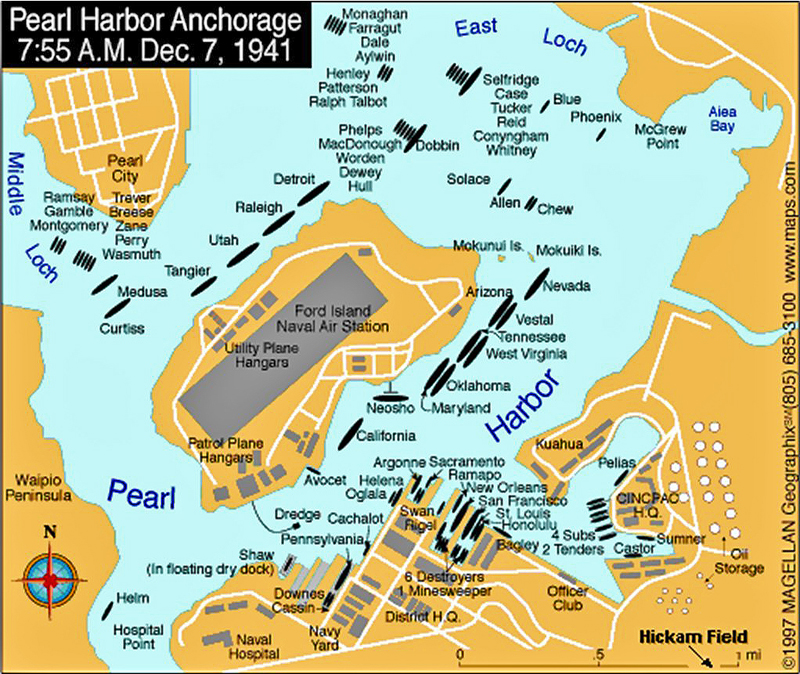 |
The Japanese have sent 6 carriers, Akagi, Kaga, Hiryu, Soryu, Zuikaku and Shokaku, with a total of 423 planes embarked to make the attack. The pilots are brilliantly trained and their equipment is good. Adm Chuichi Nagumo commands and he has, in addition to the carriers, 2 battleships and 2 heavy cruisers in his force along with destroyers and other supporting vessels including tankers.
Two waves of attacks are sent in. Commander Mitsuo Fuchida leads the first strike with 40 torpedo bombers (with special shallow running torpedoes), 51 dive bombers, 50 high-level bombers and 43 fighters. The second wave is of similar total strength but with extra dive bombers replacing the torpedo aircraft. All 8 US battleships in port are damaged, 5 of them sinking.(Arizona is a total loss; Oklahoma will be raised but scrapped; California, Nevada, and West Virginia will be rebuilt and will rejoin the fleet later in the war.) 1 minelayer and 1 target ship are also sunk. Besides 4 battleships, 3 cruisers, 3 destroyers, 1 seaplane tender and 1 repair ship are damaged. In addition to Pearl Harbor, other Japanese targets include the Naval Air Station, Ford Island; the Naval Patrol Plane Station, Kaneohe; the Marine Corps field, Ewa; the Army airfields Hickam, Wheeler and Bellows. The Americans lose 188 aircraft from the island's airfields. The Japanese lose 29 planes and 55 men. Reported casualties are 2,729 dead and 656 wounded. In 1955 official figures are given as 2,330 dead and 1,347 wounded.
United States naval vessels sunk by air attack, Pearl Harbor:
- Battleship Oklahoma (BB-37) (k-416,w-44)
- Battleship Arizona (BB-39) (k-1007,w-39)
- Battleship California (BB-44) (k-92,w-97)
- Battleship West Virginia (BB-48) (k-105,w-83)
- Minelayer Oglala (CM-4) (w-5)
- Target ship Utah (AG-16) (k-58,w-12)
United States naval vessels damaged, Pearl Harbor:
- Battleship Nevada (BB-36) (k-57,w-112)
- Battleship Pennsylvania (BB-38) (k-29,w-29)
- Battleship Tennessee (BB-43) (k-5,w-27)
- Battleship Maryland (BB-46) (k-4,w-20)
- Light cruiser Raleigh (CL-7) (w-7)
- Light cruiser Honolulu (CL-48) (w-1)
- Light cruiser Helena (CL-50) (k-34,w-63)
- Destroyer Cassin (DD-372) (w-6)
- Destroyer Shaw (DD-373) (k-24,w-27)
- Destroyer Downes (DD-375) (k-18,w-6)
- Seaplane tender Curtiss (AV-4) (k-20,w-59)
- Repair ship Vestal (AR-4) (k-7,w-81)
USS Shaw Explodes
|
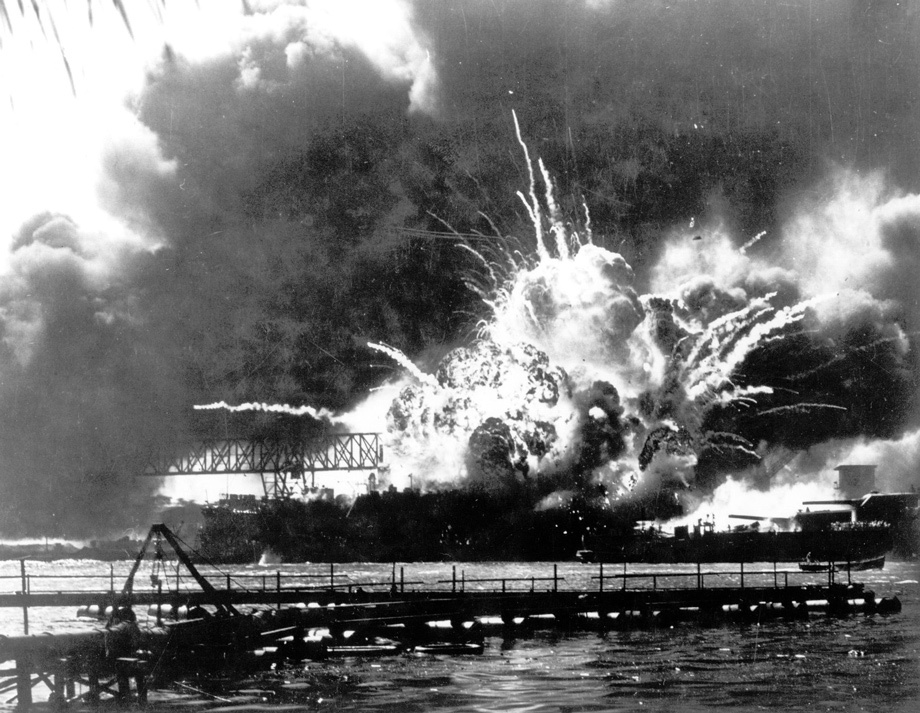 |
|
USS California Hit by Two Bombs
|
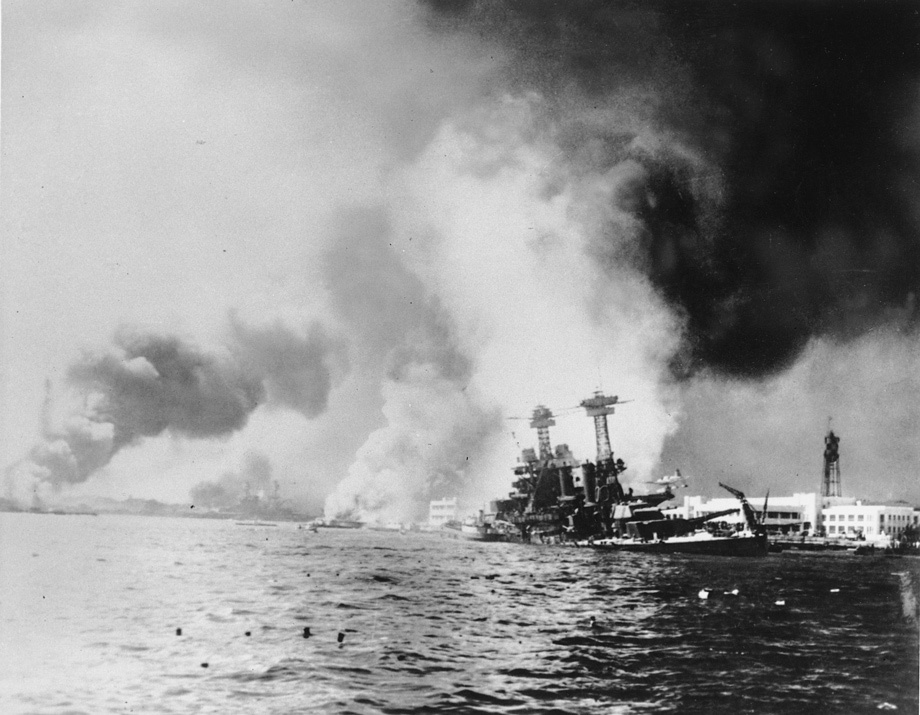 |
|
USS California On Fire
|
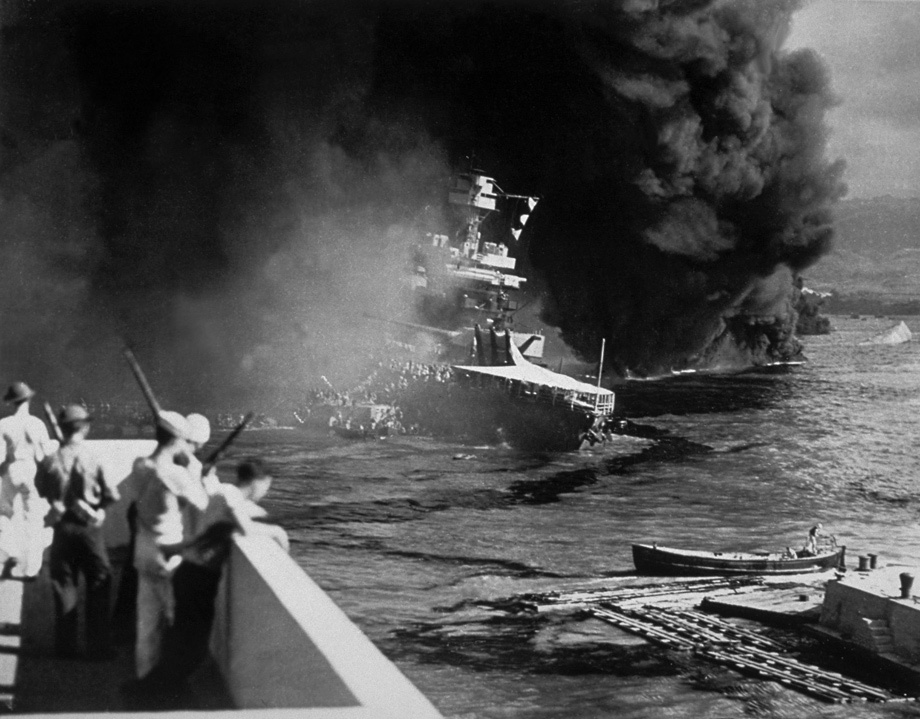 |
|
Aerial View of the Air Base at Wheeler Airfield
|
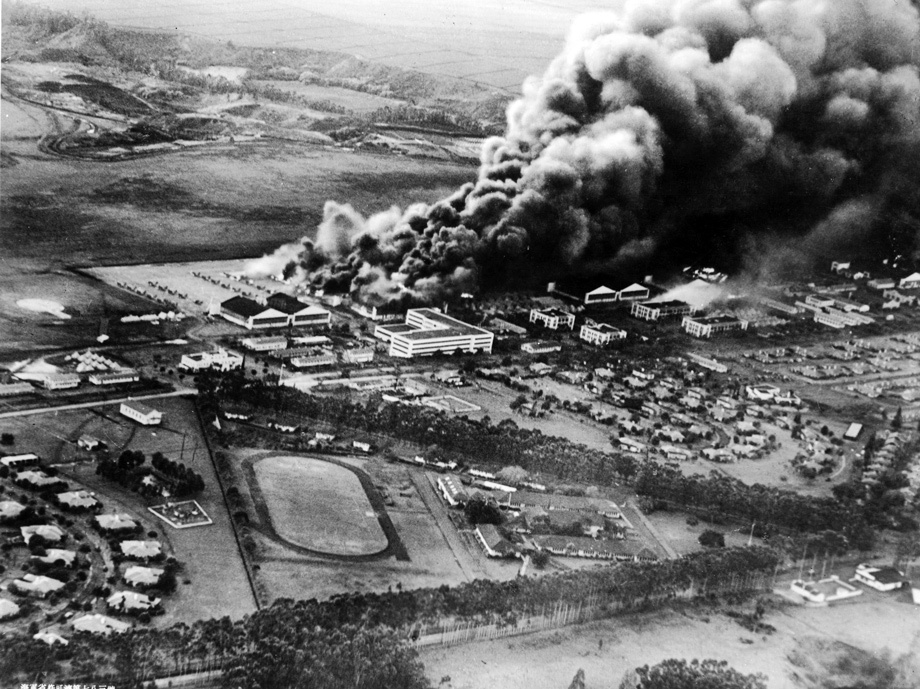 |
|
Water Rescue of Sailors from the West Virginia
|
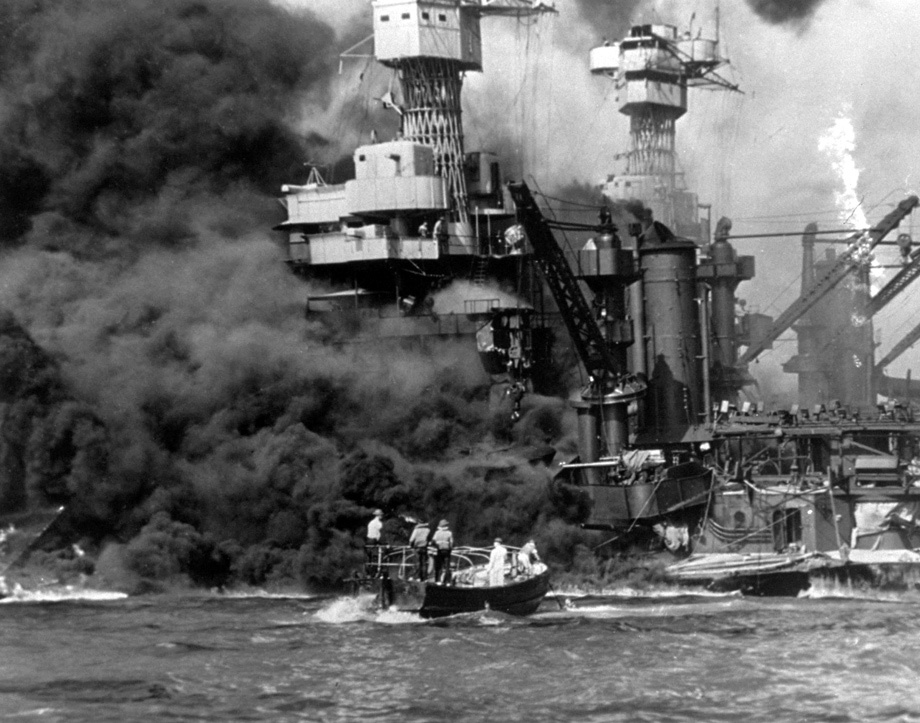 |
|
The Arizona Rolling Over
|
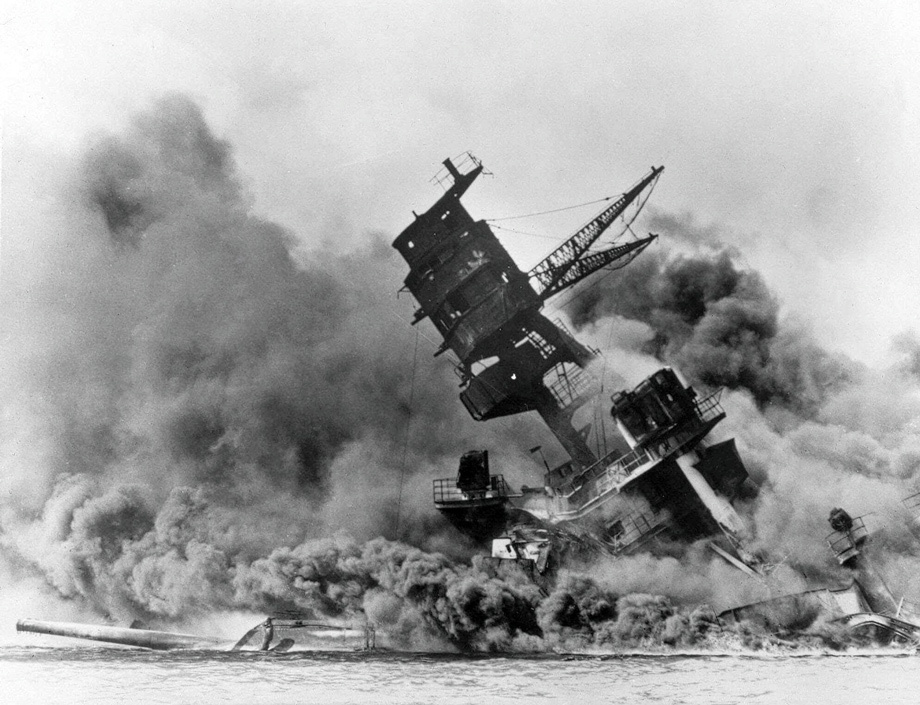 |
|
Torpedo Plane on the Shokaku
|
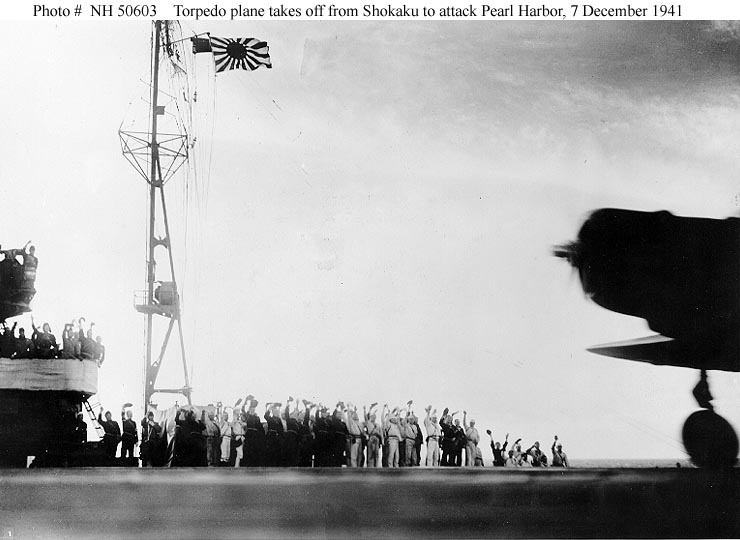 |
|
Utah Capsizing at Pear Harbor
|
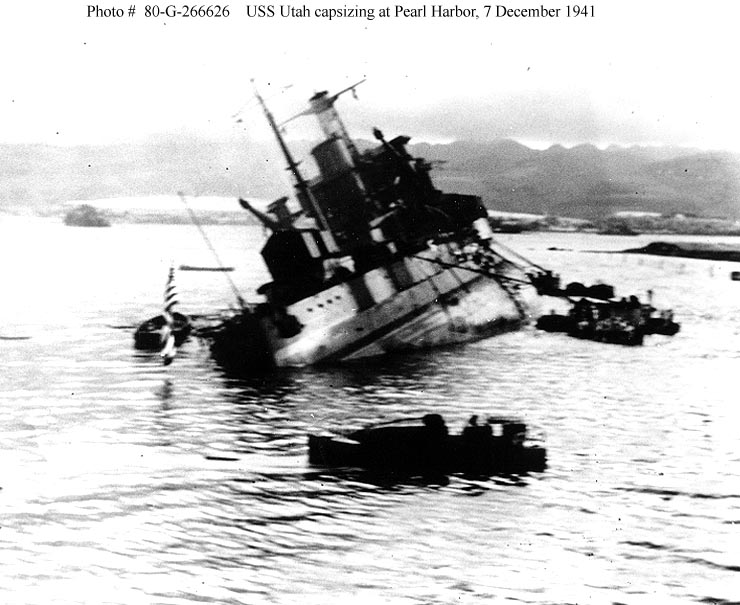 |
|
Arizona burning at Pearl Harbor
|
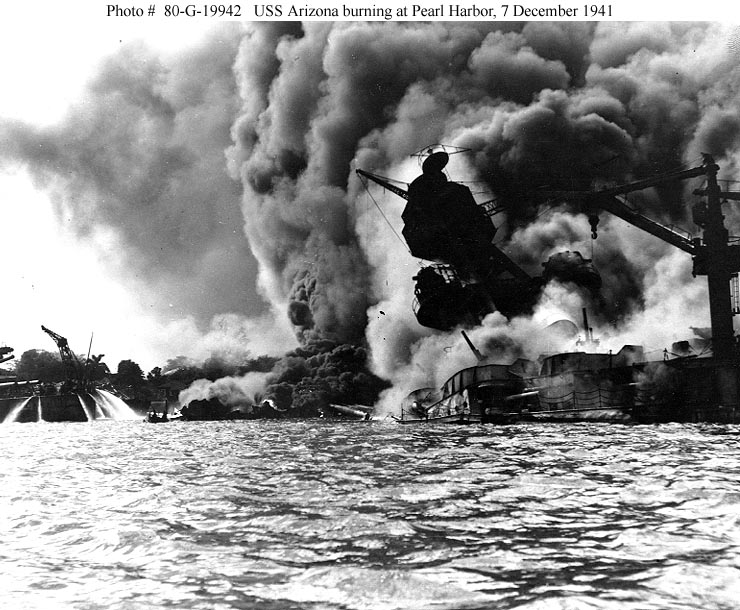 |
|
The Maryland and the Capsized Oklahoma
|
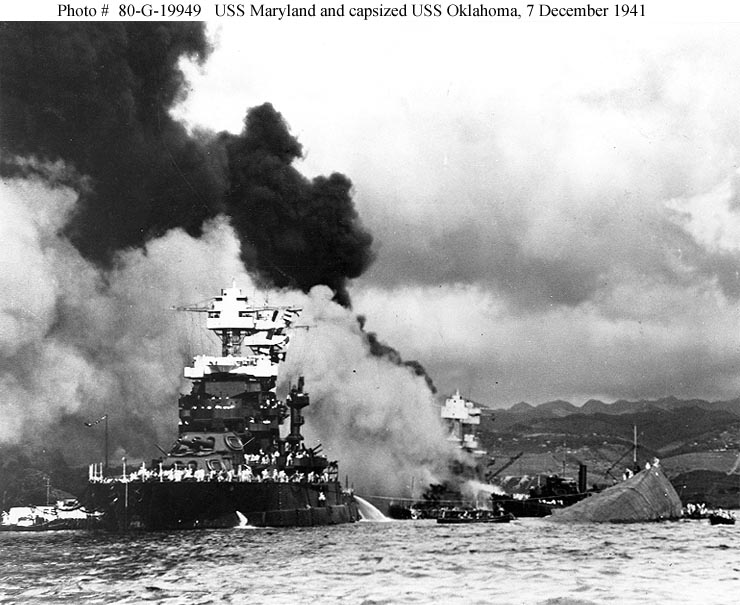 |
|
The Wrecks of the Downes and Cassin
|
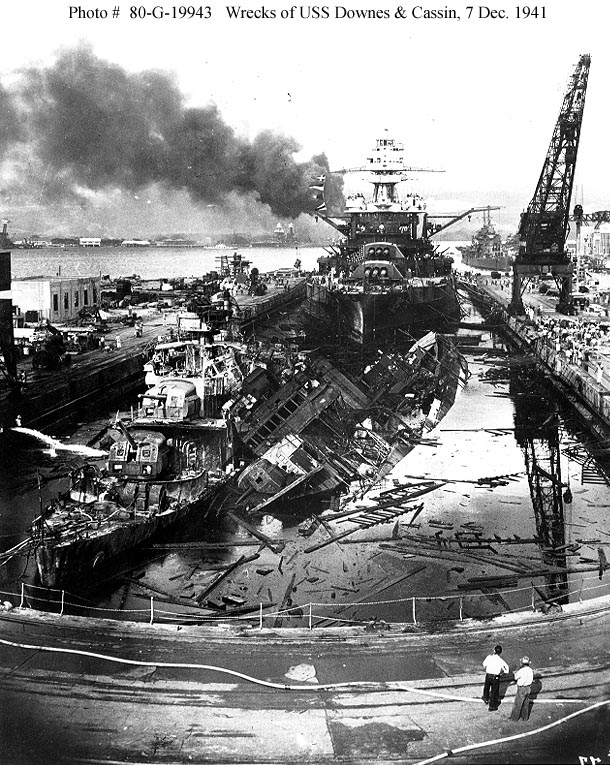 |
|
Burning PBY at NAS Kaneohe after the Japanese Attack
|
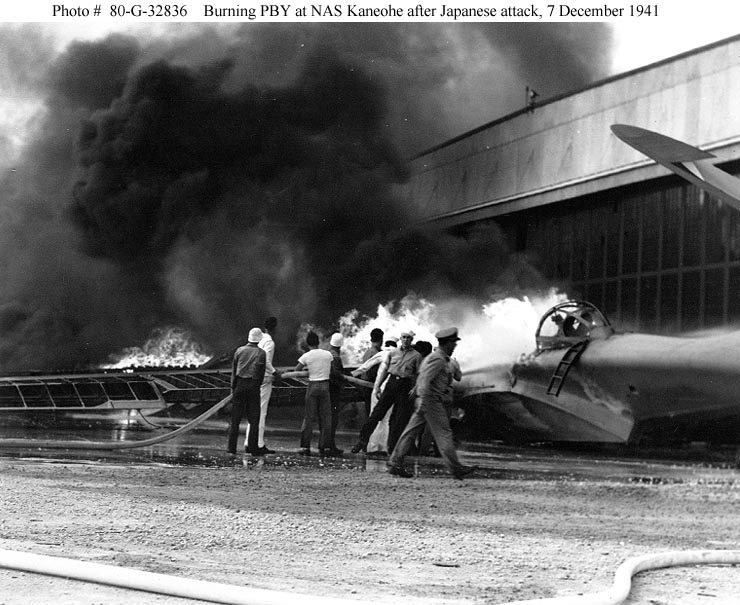 |
|
Japanese Aerial Photo of Pearl Harbor under Attack
|
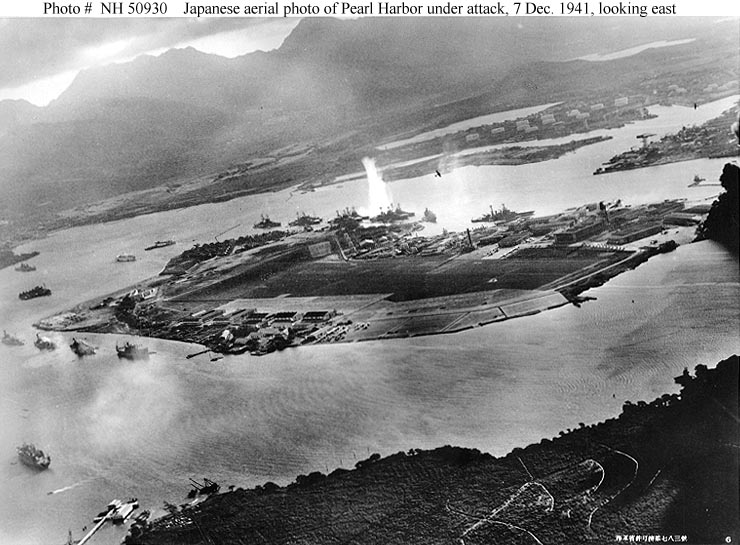 |
|
Japanese Photo of the West Side of Ford Island
|
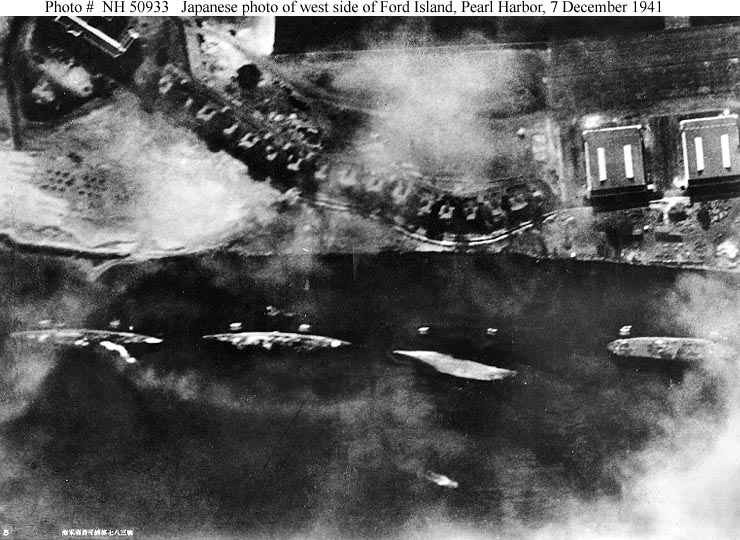 |
|
The Raleigh After She Was Torpedoed
|
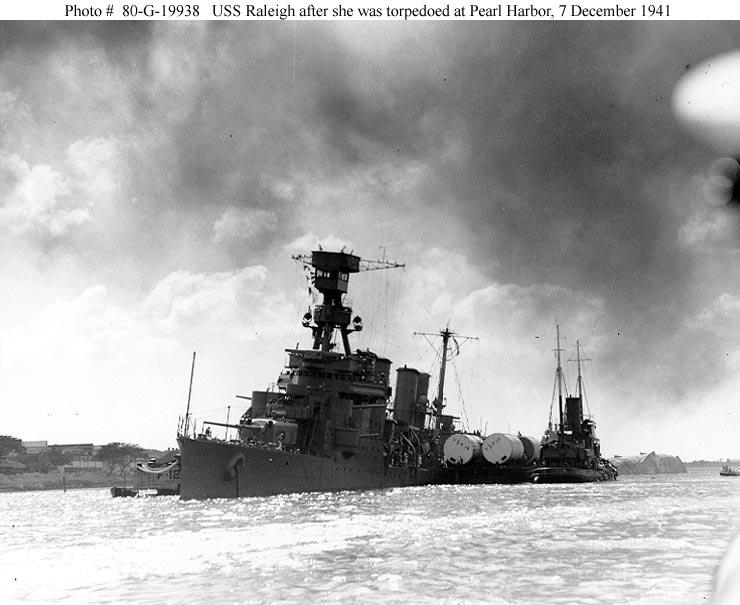 |
|
Pearl Harbor at the Beginning of the Attack
|
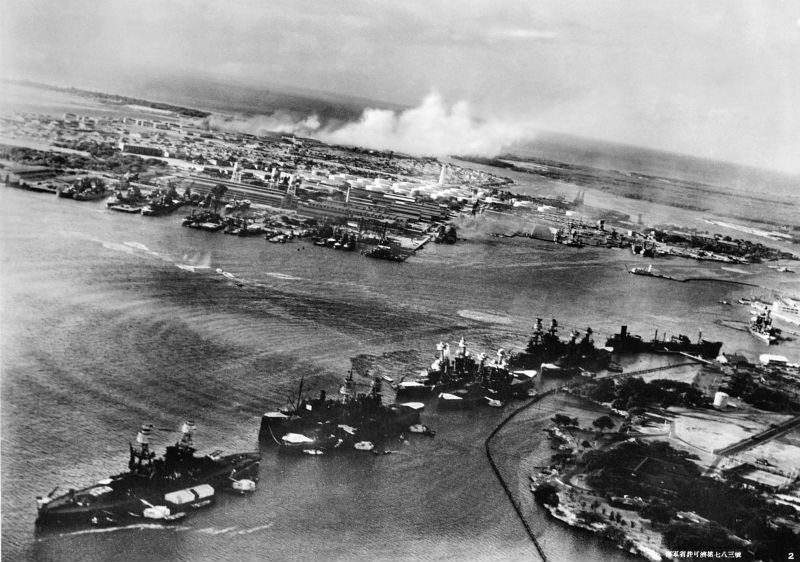 |
|
Although what is regarded at the time as the main force of the US Pacific Fleet has been destroyed before the conflict has even begun. The losses suffered here will take a long time to replace. It is perhaps more relevant to recount what escapes the Japanese attack. By a combination of coincidences all 3 carriers serving with the Pacific Fleet at this time are absent when the Japanese attack, and of necessity they will become the major element in the USN forces. The base installations at Pearl Harbor including the massive oil storage tanks also escape unhurt because Nagumo unwisely disregards the advice of his staff to send in a third attack. The Americans are, therefore, left with their base intact and the nucleus of a more modern fleet still in being. One aspect of the Japanese attack plan is a complete failure. They have sent off 5 midget submarines to try to penetrate the American anchorage but all of these are lost. One is attacked by the destroyer Ward (DD-139) at about 0630 but, since it has not been unknown for destroyers to make false submarine reports, no great stir is caused. When compared with the wonderful successes of their airmen, the failure of the Japanese submarine service is especially disappointing and this has a disproportionate effect on the later Japanese naval effort. The submarine service will find its work devalued and there will be no Japanese equivalent of the U-Boat offensive in the Atlantic. The tactical doctrine of the Japanese submarine service is also faulty in its
emphasis on attacking enemy warships and disregarding commerce destroying. It will be on the US Navy which will mount an increasingly effective submarine offensive, destroying a growing proportion of the Japanese gaining anything like the desired benefit from the resources of Malaysia and the East Indies because of their inability to ship the raw materials back to Japanese factories and refineries. It is ironic that access to these resources is the principal Japanese war aim and that, although they will be taken, they will be of disappointingly little use. It should be noted that it will be some time before the US submarine campaign begins to be effective because of depth keeping and fuse defects in their torpedoes which will take time to remedy. (The Germans had similar trouble off Norway in 1940.)
The sighting report of the Ward is not the only warning received by the US authorities. Even more exact warning comes from one of Oahu's 5 radar stations. Two conscientious operators stay on watch for longer than the prescribed early morning period and just after 0700 they detect the Japanese strike approaching. Their reports are disregarded by the junior officer they contact who believes that they must be American aircraft. To add to this is the information from the diplomatic radio traffic that a deadline for action is imminent, and a mass of lower level radio information that some Japanese moves are about to take place. No radio intelligence is received concerning the position of the Japanese carriers, but no sinister interpretation is placed on this silence. A similar radio pattern has occurred during previous Japnese moves against Indochina in which the carriers were not involved. It is, therefore, easy to assume that, although the Japanese may be up to something, the carriers may not be involved. The US commanders at Pearl Harbor base have been kept fully informed of the intelligence situation, & their general conclusion has been that, since none of the evidence points more specifically to Pearl Harbor than elsewhere, it is unnecessary to order a very high state of readiness. Instead, US aircraft are found parked wingtip to wingtip on the island's airfields; there are no torpedo nets to protect fleet anchorage; partly because it is a Sunday officers and crew from the ships are ashore and few antiaircraft guns are manned; many ammunition boxes for AA guns are kept locket because peacetime custom decrees that every round must be accounted for. Adm Kimmel, Commander in Chief US Pacific Fleet, and Gen Short, commanding US Army forces in Hawaii, will be dismissed for this catalog of errors.
At the highest level of the US command criticism is also deserved. The proverbially poor relations between the US Army and Navy are one cause of the difficulty. More understandably the misguided audacity of the Japanese is a very real surprise. The American leaders all find it easier to believe that the Japanese might attack Singapore, for example, since this would leave the US Government with the political problem of whether is could declare war to help Britain defend colonies, when the whole idea of empire is ideologically obnoxious to American opinion and without an attack on American territory.
The Pearl Harbor attack leaves the Allies with the 3 US carriers and the 2 doomed British battleships at Singapore as the only active capital ships left to face the Japanese. Counting Dutch and Free French ships the Allies have only a slight inferiority in cruisers, destroyers and submarines, but the Allied forces are widely dispersed and there will be problems of coordianation and command.
|
















